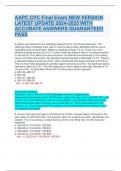AAPC CPC Final Exam NEW VERSION
LATEST UPDATE 2024-2025 WITH
ACCURATE ANSWERS GUARANTEED
PASS
A patient was referred to the radiology department for chronic low back pain. The
radiology report indicated there was no marrow abnormality identified and the conus
medullaris was unremarkable. Additional findings include: L4-L5: There is a minor
diffusely bulging annulus at L4-L5. A small focal disc bulge is seen in far lateral position
on the left at L4-L5 within the neural foramen. No definite encroachment on the exiting
nerve root at this site is seen. No significant spinal stenosis is identified. L5-S1: There is
a diffusely bulging annulus at L5-S1, with a small focal disc bulge centrally at this level.
There is minor disc desiccation and disc space narrowing at L5-S1. No significant spinal
stenosis is seen at L5-S1. The final diagnosis is minor degenerative disc disease at L4-
L5 and L5-S1, as described. What ICD-10-CM code(s) is/are reported?
a. M51.36, M51.37
b. M51.36
c. M51.37, M54.50
d. M51.36, M54.50
- Ans - b. M51.36, M51.37
Response Feedback:
Rationale: Look in the ICD-10-CM Alphabetic Index for Degeneration,
degenerative/intervertebral disc NOS/lumbar region directing you to code M51.36. Look
in the ICD-10-CM Alphabetic Index for Degeneration, degenerative/intervertebral disc
NOS/lumbosacral region directing you to code M51.37. Verify code selection in the
Tabular List. The low back pain is a symptom of the degenerative disc disease and is
not reported separately.
A 16-year-old male is brought to the ED by his mother. He was riding his bicycle in the
park when he fell off the bike. The patient's right arm is painful to touch, discolored, and
swollen. The X-ray shows a closed fracture of the ulna. What ICD-10-CM codes are
reported?
a. S52.201A, V18.0XXA, Y92.830
b. S52.201A, V18.4XXA, Y92.831
c. S52.209A, V18.4XXA, Y92.830
d. S52.201A, V19.9XXA, Y92.830
- Ans - a. S52.201A, V18.0XXA, Y92.830
,A child is seen in a hospital based pediatric clinic for active treatment of 10% first and
second degree burns to the left calf area and 5% third degree burns on her right hand.
What ICD-10-CM codes are reported?
a. T23.301A, T24.232A, T24.132A
b. T23.291A, T24.202A
c. T23.301A, T24.232A
d. T24.202A, T23.301A, T24.132A
- Ans - c. T23.301A, T24.232A
Response Feedback:Rationale: Burns are classified as burns or corrosions in ICD-10-
CM. In this scenario, there is no specification as to what caused the burns, but they are
stated as burns. ICD-10-CM guideline I.C.19.d.1 indicates to sequence first the code
that reflects the highest degree of burn when more than one is present. In this case, the
third degree burn on the right hand is listed first. In the ICD-10-CM Alphabetic Index,
look for Burn/hand(s)/right/third degree directing you to T23.301-. In the Tabular List, a
7 th character A is reported for the initial encounter (active treatment). ICD-10-CM
guideline I.C.19.d.2 indicates to code burns of the same site, but of different degrees to
the subcategory identifying the highest degree recorded. Therefore, report second
degree burns to the left calf. Look in the Alphabetic Index for Burn/calf/left/second
degree T24.232. In the Tabular List a 7th character A is reported for the initial
encounter. ICD-10-CM guideline I.C.19.d.6 indicates a code from category T31 is
reported when there is mention of a third-degree burn involving 20% or more of the
body surface. This does not apply in this case, so a code from T31 is not required
(unless reporting for a burn unit or other facility requiring the additional data). The codes
in the burn section have a note to use additional external cause codes to identify the
source, place and intent of the burn. This information is not known in this case so it
cannot be reported. Verify code selection in the Tabular List.
What type of CPT® code is "modifier 51 exempt" even though there is no modifier 51
exempt symbol next to it?
a. Surgery codes
b. Mandated services
c. Bilateral procedures
d. Add-on codes
- Ans - d. Add-on codes
What publications does the AMA copyright and maintain?
a. CPT® code book, HCPCS Level II codebook, ICD-10-CM codebook
b. CPT® codenbook and CPT® Assistant
c. CPT® codenbook and HCPCS Level II codebook
, d. AHA Coding Clinic and CPT® Assistant - Ans - b. CPT® codenbook and CPT®
Assistant
What modifier is used to report the termination of a surgery following induction of
anesthesia due to extenuating circumstances or those that threaten the well-being of
the patient?
a. Modifier 53
b. Modifier 22
c. Modifier 52
d. Modifier 54
- Ans - a. Modifier 53
Response Feedback:
Rationale: Modifier 53 is used to indicate the physician has elected to terminate a
surgical or diagnostic procedure due to extenuating circumstances or those that
threaten the well-being of the patient. CPT® modifiers are found on the inside front
cover and in Appendix A of the CPT® code book.
CPT® Category III codes reimburse at what level?
a. 100 percent
b. 85 percent
c. 10 percent
d. Reimbursement, if any, is determined by the payer
- Ans - d. Reimbursement, if any, is determined by the payer
Response Feedback:Rationale: Per AMA, there are no relative value units (RVUs)
assigned to these codes. Payment for these services or procedures is based on the
policies of payers.
What is the correct code for the application of a short arm cast?
a. 29075
b. 29280
c. 29065
d. 29125
- Ans - a. 29075
Rationale: In the CPT® Index, look for Cast/Type/Ambulatory/Short Arm. The code you
are directed to use is 29075.
A patient presents to the office with a suspicious lesion of the nose. The physician takes
a biopsy of the lesion and pathology determines the lesion to be uncertain. What is the
correct diagnosis code to report?
a. D22.39
b. C44.301
c. D48.5
d. D49.2




